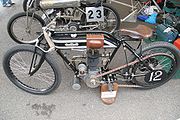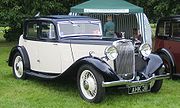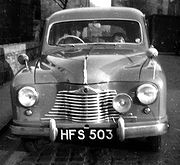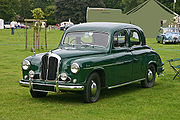.gif)
Singer (car)
Encyclopedia
Singer was an automobile
company founded in 1905 in Coventry
, England. It was acquired by the Rootes Group of the United Kingdom in 1956, who continued the brand until 1970. The British Singer company had no connection with the Singer company of Mount Vernon
, New York, USA, which made luxury cars from 1915 to 1920.
to make bicycles in 1875.
.gif) In 1904 they developed a range of more conventional motorcycles which included 346 cc two strokes and, from 1911, side-valve models of 299 cc and 535 cc. In 1913 they offered an open-frame ladies model.
In 1904 they developed a range of more conventional motorcycles which included 346 cc two strokes and, from 1911, side-valve models of 299 cc and 535 cc. In 1913 they offered an open-frame ladies model.
 In 1909 Singer built a series of racers and roadsters and entered several bikes in races, including the Isle of Man
In 1909 Singer built a series of racers and roadsters and entered several bikes in races, including the Isle of Man
Senior TT in 1914. George E. Stanley
broke the one hour record at Brooklands
race track on a Singer motorcycle in 1912, becoming the first ever rider of a 350 cc motorcycle to cover over 60 miles (96.6 km) in an hour.
Singer stopped building motorcycles at the outbreak of the First World War
.
having a 2-cylinder 1853 or 2471 cc engine.
The first Singer designed car was the 4-cylinder 2.4 litre 12/14 of 1906. The engine was bought in from Aster
. For 1907 the Lea-Francis design was dropped and a range of two-, three- and four-cylinder models using White and Poppe
engines launched. The Aster engined models were dropped in 1909 and a new range of larger cars introduced. All cars were now White and Poppe powered. In 1911 the first big seller appeared with the four cylinder 1100 cc Ten with Singer's own engine. The use of their own power plants spread through the range until by the outbreak of the First World War all models except the low-volume 3.3 litre 20 hp were so equipped.
The Ten continued after the war, with a redesign in 1923 including a new overhead-valve engine. Six-cylinder models were introduced in 1922. In 1921 Singer took over another Coventry car maker Coventry Premier
and continued to sell a range of cars under that name until 1924. Calcott
was purchased in 1926. For 1927 the Ten engine grew to 1300 cc and a new light car with 850 cc overhead cam (ohc) engine, the big selling Junior was announced and at the same time the ten became the Senior. By 1928 Singer was Britain's third largest car maker after Austin
and Morris
. The range continued in a very complex manner using developments of the ohc Junior engine first with the Nine (two bearing crank), the 14/6 and the sporty 1½-litre in 1933. The Nine became the Bantam
in 1935. Externally the Bantam was very similar to the Morris Eight, had a three-bearing crankshaft and it was the first Singer to be fitted with a synchromesh gearbox, albeit with only three forward gears.
After the Second World War
the pre-war Nine, Ten and Twelve were initially re-introduced with little change. In 1948 the SM1500 with independent front suspension and a separate chassis was announced, still using the SOHC 1500cc engine. It was, however, expensive at £799, and failed to sell well as Singer's rivals also got back into full production. The car was restyled to become the Hunter in 1954. The Hunter was available with an HRG-designed twin overhead-cam version of the engine, but few were made.
versions of each others cars. The next Singer car, the Gazelle
, was a Hillman Minx
variant that retained the pre-war designed Singer ohc engine for the I and II versions but this too went in 1958 when the IIA was given a push-rod engine. The Vogue, which ran alongside the Gazelle from 1961, was a rebadged Hillman Super Minx with more luxurious trim.
By 1970, Rootes were beginning to struggle financially. They had been acquired by the American Chrysler
organisation, and founder Sir William had died in 1964. In April 1970, as part of a rationalisation process, the last Singer rolled off the assembly line, almost 100 years after George Singer built the first cycle. The last car to carry the Singer name was an upmarket version of the rear engined Hillman Imp
called the Chamois. With the take over of Rootes by Chrysler begun in 1964 and completed in 1967, many of the brands were to vanish and the Singer name disappeared forever in 1970. The site of the Singer factory in Coventry is now occupied by Singer Hall, a hall of residence
for Coventry University
.
——————————————————————————————————————————————
——————————————————————————————————————————————
——————————————————————————————————————————————
——————————————————————————————————————————————
Automobile
An automobile, autocar, motor car or car is a wheeled motor vehicle used for transporting passengers, which also carries its own engine or motor...
company founded in 1905 in Coventry
Coventry
Coventry is a city and metropolitan borough in the county of West Midlands in England. Coventry is the 9th largest city in England and the 11th largest in the United Kingdom. It is also the second largest city in the English Midlands, after Birmingham, with a population of 300,848, although...
, England. It was acquired by the Rootes Group of the United Kingdom in 1956, who continued the brand until 1970. The British Singer company had no connection with the Singer company of Mount Vernon
Mount Vernon, New York
Mount Vernon is a city in Westchester County, New York, United States. It lies on the border of the New York City borough of The Bronx.-Overview:...
, New York, USA, which made luxury cars from 1915 to 1920.
Bicycles
The company was established by George Singer (1847-1908) in CoventryCoventry
Coventry is a city and metropolitan borough in the county of West Midlands in England. Coventry is the 9th largest city in England and the 11th largest in the United Kingdom. It is also the second largest city in the English Midlands, after Birmingham, with a population of 300,848, although...
to make bicycles in 1875.
Motorcycles
The company began manufacturing motorised three-wheelers in 1901, followed by motorwheels which were fitted to bicycles. Singer developed a 222 cc four-stroke single using an engine design bought from former Beeston employees Edwin Perks and Frank Birch. A unique feature of the Perks-Birch design was that the engine, fuel tank, carburettor and low-tension magneto were all housed in a two-sided cast alloy spoked wheel. It was probably the first motor bicycle to be provided with magneto ignition. The design was used by Singer in the rear wheel and then the front wheel of a trike..gif)

Isle of Man
The Isle of Man , otherwise known simply as Mann , is a self-governing British Crown Dependency, located in the Irish Sea between the islands of Great Britain and Ireland, within the British Isles. The head of state is Queen Elizabeth II, who holds the title of Lord of Mann. The Lord of Mann is...
Senior TT in 1914. George E. Stanley
George E. Stanley
George Enoch Stanley was a British motorcyclist who was a member of ‘The British Motorcycle Racing Club’-History:...
broke the one hour record at Brooklands
Brooklands
Brooklands was a motor racing circuit and aerodrome built near Weybridge in Surrey, England. It opened in 1907, and was the world's first purpose-built motorsport venue, as well as one of Britain's first airfields...
race track on a Singer motorcycle in 1912, becoming the first ever rider of a 350 cc motorcycle to cover over 60 miles (96.6 km) in an hour.
Singer stopped building motorcycles at the outbreak of the First World War
World War I
World War I , which was predominantly called the World War or the Great War from its occurrence until 1939, and the First World War or World War I thereafter, was a major war centred in Europe that began on 28 July 1914 and lasted until 11 November 1918...
.
Motor cars
Singer made first four wheel car in 1905. It was designed by Alexander Craig and was a variant of a design he had done for Lea-FrancisLea-Francis
Lea-Francis was a motor manufacturing company that began life building bicycles.- History :Richard Henry Lea and Graham Inglesby Francis started the business in Coventry in 1895. They branched out into car manufacture in 1903 and motor cycles in 1911. Lea-Francis built cars, under licence, for the...
having a 2-cylinder 1853 or 2471 cc engine.
The first Singer designed car was the 4-cylinder 2.4 litre 12/14 of 1906. The engine was bought in from Aster
Aster (auto parts company)
Aster was a French manufacturer of automobile parts; from 1900 to 1910 the company produced chassis, though it is not known if they built complete cars.The firm whose full name was Ateliers de Construction Mecanique l'Aster from St...
. For 1907 the Lea-Francis design was dropped and a range of two-, three- and four-cylinder models using White and Poppe
White and Poppe
White and Poppe was a Coventry based proprietary engine and gearbox manufacturer established in 1899 by Alfred James White and Peter August Poppe. White was a watchmaker and Poppe an engineer and together they produced precision parts for the automotive industry...
engines launched. The Aster engined models were dropped in 1909 and a new range of larger cars introduced. All cars were now White and Poppe powered. In 1911 the first big seller appeared with the four cylinder 1100 cc Ten with Singer's own engine. The use of their own power plants spread through the range until by the outbreak of the First World War all models except the low-volume 3.3 litre 20 hp were so equipped.
The Ten continued after the war, with a redesign in 1923 including a new overhead-valve engine. Six-cylinder models were introduced in 1922. In 1921 Singer took over another Coventry car maker Coventry Premier
Coventry Premier
The Coventry Premier was a British car and cyclecar manufacturer based in Coventry from 1912 to 1923.The company can trace its origins back to 1876 when the Hillman and Herbert company was founded as bicycle makers. William Hillman went on to set up his own Hillman car company in 1907...
and continued to sell a range of cars under that name until 1924. Calcott
Calcott
For the village in Shropshire, see Calcott, Shropshire Calcott is a village on the A291 road, in the Canterbury District, in the English county of Kent....
was purchased in 1926. For 1927 the Ten engine grew to 1300 cc and a new light car with 850 cc overhead cam (ohc) engine, the big selling Junior was announced and at the same time the ten became the Senior. By 1928 Singer was Britain's third largest car maker after Austin
Austin Motor Company
The Austin Motor Company was a British manufacturer of automobiles. The company was founded in 1905 and merged in 1952 into the British Motor Corporation Ltd. The marque Austin was used until 1987...
and Morris
Morris Motor Company
The Morris Motor Company was a British car manufacturing company. After the incorporation of the company into larger corporations, the Morris name remained in use as a marque until 1984 when British Leyland's Austin Rover Group decided to concentrate on the more popular Austin marque...
. The range continued in a very complex manner using developments of the ohc Junior engine first with the Nine (two bearing crank), the 14/6 and the sporty 1½-litre in 1933. The Nine became the Bantam
Singer Bantam
The Singer Bantam is a car formerly made by the Singer Motor Company. It was the first model produced by the company to have a Pressed Steel body. It was offered as a new economy model at the 1935 Motor Show in London.-History:...
in 1935. Externally the Bantam was very similar to the Morris Eight, had a three-bearing crankshaft and it was the first Singer to be fitted with a synchromesh gearbox, albeit with only three forward gears.
 |
 |
.jpg) |
After the Second World War
World War II
World War II, or the Second World War , was a global conflict lasting from 1939 to 1945, involving most of the world's nations—including all of the great powers—eventually forming two opposing military alliances: the Allies and the Axis...
the pre-war Nine, Ten and Twelve were initially re-introduced with little change. In 1948 the SM1500 with independent front suspension and a separate chassis was announced, still using the SOHC 1500cc engine. It was, however, expensive at £799, and failed to sell well as Singer's rivals also got back into full production. The car was restyled to become the Hunter in 1954. The Hunter was available with an HRG-designed twin overhead-cam version of the engine, but few were made.
.jpg) |
 |
 |
Rootes Group
By 1956 the company was in financial difficulties and Rootes Brothers, who had handled Singer sales since before the First World War, bought the company. The Singer brand was absorbed into the Rootes Group, whose brands largely sold badge engineeredBadge engineering
Badge engineering is an ironic term that describes the rebadging of one product as another...
versions of each others cars. The next Singer car, the Gazelle
Singer Gazelle
The Singer Gazelle name has been applied to two generations of motor cars from the British manufacturer the Rootes Group, using the Singer marque...
, was a Hillman Minx
Hillman Minx
The Hillman Minx was a series of middle-sized family cars produced under the Hillman marque by the Rootes Group between 1932 and 1970...
variant that retained the pre-war designed Singer ohc engine for the I and II versions but this too went in 1958 when the IIA was given a push-rod engine. The Vogue, which ran alongside the Gazelle from 1961, was a rebadged Hillman Super Minx with more luxurious trim.
By 1970, Rootes were beginning to struggle financially. They had been acquired by the American Chrysler
Chrysler
Chrysler Group LLC is a multinational automaker headquartered in Auburn Hills, Michigan, USA. Chrysler was first organized as the Chrysler Corporation in 1925....
organisation, and founder Sir William had died in 1964. In April 1970, as part of a rationalisation process, the last Singer rolled off the assembly line, almost 100 years after George Singer built the first cycle. The last car to carry the Singer name was an upmarket version of the rear engined Hillman Imp
Hillman Imp
The Hillman Imp is a compact, rear-engined saloon car that was manufactured under the Hillman marque by the Rootes Group from 1963 to 1976...
called the Chamois. With the take over of Rootes by Chrysler begun in 1964 and completed in 1967, many of the brands were to vanish and the Singer name disappeared forever in 1970. The site of the Singer factory in Coventry is now occupied by Singer Hall, a hall of residence
Dormitory
A dormitory, often shortened to dorm, in the United States is a residence hall consisting of sleeping quarters or entire buildings primarily providing sleeping and residential quarters for large numbers of people, often boarding school, college or university students...
for Coventry University
Coventry University
Coventry University is a post-1992 university in Coventry, West Midlands, England. Under the terms of the Further and Higher Education Act of 1992, the institution's name was changed from Coventry Polytechnic to Coventry University...
.
Models
The main models produced were:- Ten 1400 cc 1905
- Twelve/Fourteen 2400 cc 1906–10
- Twenty/Twenty-five 3500 cc 1908–10
- Fifteen 2600 cc 1911–14
- Ten 1100 cc 1912–23
- Ten/Twenty-six 1300 cc 1925–27
- Fourteen/Thirty-four and Senior 1800 cc 1926–27
- Light Six 1800 cc 1929–31
- Senior Six 1600 cc 1927–30
- Super Six 1920 cc 1930–31
- Junior 850 cc 1927–35
- Nine 972 cc 1933–37 ifs, optional fluidrive £10
- Nine Le Mans or Special Speed
- 1½ litre 1500 cc 1933–37
- Fourteen Six 1612 cc
- Silent Six 2160 cc and Continental sports saloon (=Kaye Don Special?)
- Eleven May 1934 ifs, fluidrive
- Sixteen Six 1993 cc Aug 1934- ifs, fluidrive
- Silent Six 2366 cc 1934- ifs, fluidrive
- BantamSinger BantamThe Singer Bantam is a car formerly made by the Singer Motor Company. It was the first model produced by the company to have a Pressed Steel body. It was offered as a new economy model at the 1935 Motor Show in London.-History:...
972 cc 1936–38
——————————————————————————————————————————————
- December 1936: Singer & Co Limited dissolved; business transferred to Singer Motors Limited
——————————————————————————————————————————————
- Twelve and Super Twelve 1525 cc 1937–39
- BantamSinger BantamThe Singer Bantam is a car formerly made by the Singer Motor Company. It was the first model produced by the company to have a Pressed Steel body. It was offered as a new economy model at the 1935 Motor Show in London.-History:...
1074 cc 1938–40 - Nine 1074cc 1938–1947
- Ten and Super Ten 1188 cc and later 1193cc 1938–48
- 4A RoadsterSinger RoadsterThe Singer Roadster was launched by the Singer Motor Company in 1939 as an open version of the Bantam saloon. Production was suspended for the duration of World War II following which production of the car was re-started in virtually unchanged form. It was upgraded to the 4A model in 1949 with a...
1074 cc 1949–1951 - SM1500Singer SM1500In September 1954 the car was re-branded as the Singer Hunter with a traditional radiator grille and fibreglass bonnet lid until 1955. The Hunter was well equipped with twin horns and screenwash as standard. A horse-head mascot was fitted over the radiator...
1497 cc 1948–54 - 4AD RoadsterSinger RoadsterThe Singer Roadster was launched by the Singer Motor Company in 1939 as an open version of the Bantam saloon. Production was suspended for the duration of World War II following which production of the car was re-started in virtually unchanged form. It was upgraded to the 4A model in 1949 with a...
1497 cc 1951–1955 - HunterSinger SM1500In September 1954 the car was re-branded as the Singer Hunter with a traditional radiator grille and fibreglass bonnet lid until 1955. The Hunter was well equipped with twin horns and screenwash as standard. A horse-head mascot was fitted over the radiator...
1497 cc 1954–56
——————————————————————————————————————————————
- December 1955: Singer Motors joins Rootes Group
——————————————————————————————————————————————
- Gazelle IHillman MinxThe Hillman Minx was a series of middle-sized family cars produced under the Hillman marque by the Rootes Group between 1932 and 1970...
1497 cc (Singer engine) 1956–57 - Gazelle IIHillman MinxThe Hillman Minx was a series of middle-sized family cars produced under the Hillman marque by the Rootes Group between 1932 and 1970...
1497 cc (Singer engine) 1957–58 - Gazelle IIAHillman MinxThe Hillman Minx was a series of middle-sized family cars produced under the Hillman marque by the Rootes Group between 1932 and 1970...
1500 cc (Rootes engine from now on) 1958 - Gazelle IIIHillman MinxThe Hillman Minx was a series of middle-sized family cars produced under the Hillman marque by the Rootes Group between 1932 and 1970...
1500 cc 1958–59 - Gazelle IIIAHillman MinxThe Hillman Minx was a series of middle-sized family cars produced under the Hillman marque by the Rootes Group between 1932 and 1970...
1500 cc 1959–60 - Gazelle IIIBHillman MinxThe Hillman Minx was a series of middle-sized family cars produced under the Hillman marque by the Rootes Group between 1932 and 1970...
1500 cc 1960–61 - Gazelle IIICHillman MinxThe Hillman Minx was a series of middle-sized family cars produced under the Hillman marque by the Rootes Group between 1932 and 1970...
1600 cc 1961–63 - Gazelle VHillman MinxThe Hillman Minx was a series of middle-sized family cars produced under the Hillman marque by the Rootes Group between 1932 and 1970...
1600 cc 1963–65 - Gazelle VIHillman MinxThe Hillman Minx was a series of middle-sized family cars produced under the Hillman marque by the Rootes Group between 1932 and 1970...
1725 cc 1965–67 - New GazelleSinger GazelleThe Singer Gazelle name has been applied to two generations of motor cars from the British manufacturer the Rootes Group, using the Singer marque...
1725 cc 1967–70 - Vogue IHillman MinxThe Hillman Minx was a series of middle-sized family cars produced under the Hillman marque by the Rootes Group between 1932 and 1970...
1600 cc 1961–62 - Vogue IIHillman MinxThe Hillman Minx was a series of middle-sized family cars produced under the Hillman marque by the Rootes Group between 1932 and 1970...
1600 cc 1963–64 - Vogue IIIHillman MinxThe Hillman Minx was a series of middle-sized family cars produced under the Hillman marque by the Rootes Group between 1932 and 1970...
1600 cc 1964–65 - Vogue IVHillman MinxThe Hillman Minx was a series of middle-sized family cars produced under the Hillman marque by the Rootes Group between 1932 and 1970...
1725 cc 1965–66 - New VogueHillman HunterRootes Arrow was the manufacturer's name for a range of cars produced under several badge-engineered marques by the Rootes Group from 1966 to 1979. It is amongst the last Rootes designs, developed with no influence from future owner Chrysler...
1725 cc 1966–70 - ChamoisHillman ImpThe Hillman Imp is a compact, rear-engined saloon car that was manufactured under the Hillman marque by the Rootes Group from 1963 to 1976...
875 cc 1965–70

